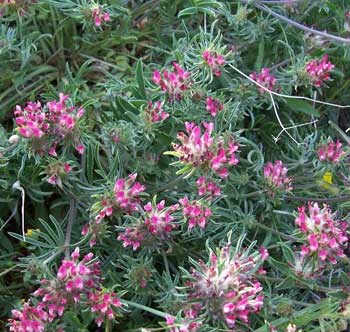Contents:
Common Names | Parts Usually Used | Plant(s) & Culture | Where Found | Medicinal Properties
Uses | Formulas or Dosages | Bibliography
Scientific Names

- Anthyllis vulneraria L.
- Pea family
Common Names
- Ladies’ fingers
- Lamb’s toes
- Staunchwort
Parts Usually Used
Flowering tops
Back to Top
Description of Plant(s) and Culture
Kidney vetch is a European perennial plant; the procumbent or erect stem grows from a strong taproot to a length of 8-16 inches. The basal leaves are petioled and simple or pinnate; the stem leaves are odd-pinnate, the leaflets lanceolate with the odd leaflet larger than the others. The yellow flowers are arranged in ovoid or subglobose, clover-like heads, appearing from May to September.
Another variety: The Chinese use a plant they call vetch (Vicia hirsuta), the Chinese name is Ch’iao-yao. Recommended for chronic malarial difficulties.
Back to Top
Where Found
Found in limestone soils, dry meadows, hills, and railroad embankments.
Back to Top
Medicinal Properties
Astringent
Back to Top
Uses
A warm infusion of kidney vetch can be used to wash wounds, which are then covered with a poultice which is renewed every hour. The tea is often given to children as a mild purgative, and it sometimes helps to allay vomiting in children.
Back to Top
Formulas or Dosages
Kidney vetch can be used fresh or dried.
Infusion: steep 1 tsp. flower heads in 1/2 cup water. Take 1 cup per day, sweetened with honey.
Back to Top
Bibliography
![]() The Herb Book
The Herb Book, by John Lust, Bantam Books, 666 Fifth Avenue, New York, NY. copyright 1974.
![]() Chinese Medicinal Herbs
Chinese Medicinal Herbs, compiled by Shih-Chen Li, Georgetown Press, San Francisco, California, 1973.
![]() Webster’s New World Dictionary
Webster’s New World Dictionary, Third College Edition, Victoria Neufeldt, Editor in Chief, New World Dictionaries: A Division of Simon & Schuster, Inc., 15 Columbus Circle, New York, NY 10023
